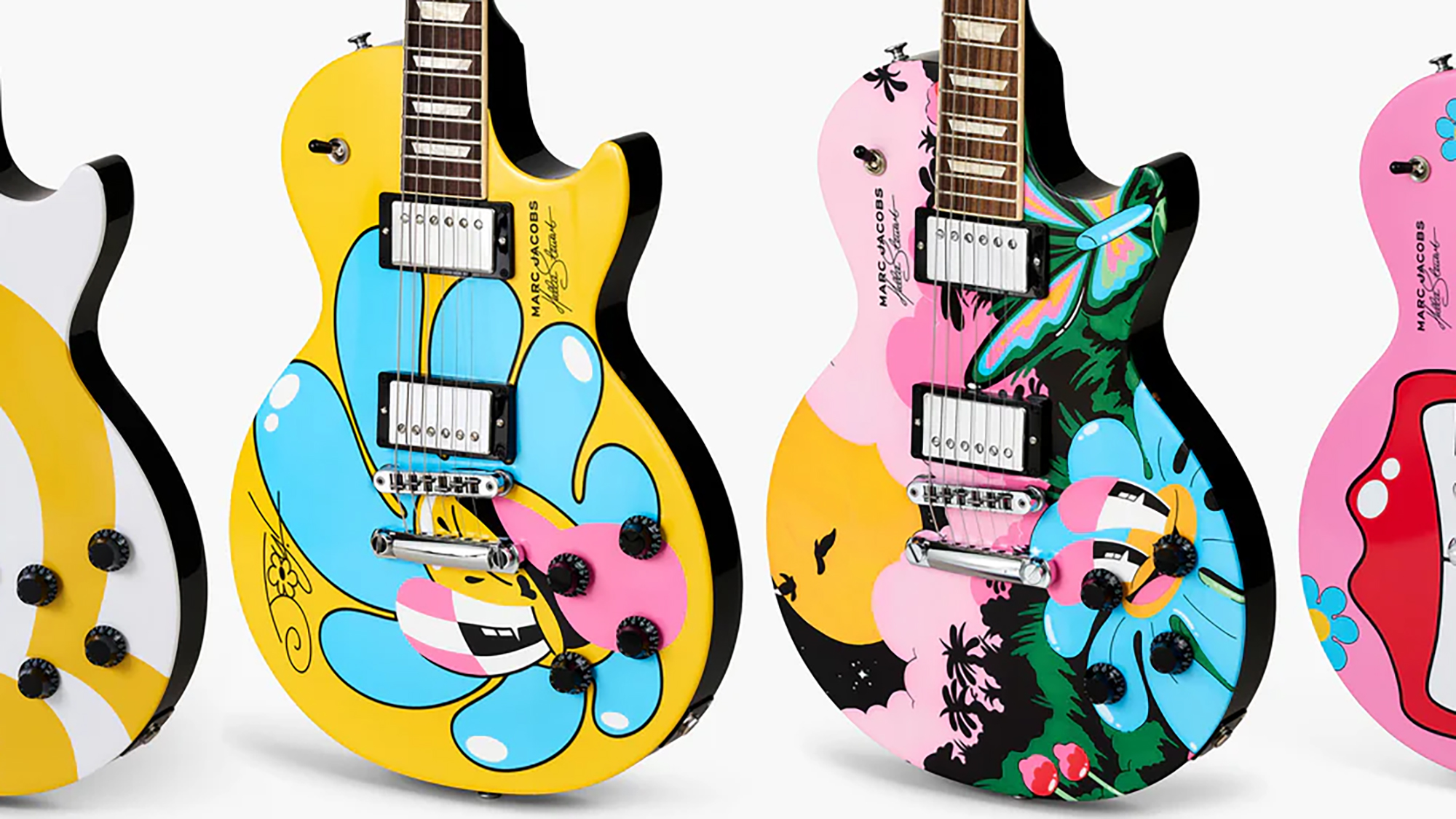Tony Iommi: "I've got hundreds of riffs - new music is going to happen"
The godfather of heavy metal goes deep on his iconic "Monkey" Gibson SG, jams with Led Zeppelin, recording with Brian May, and what he plans to do with all those unheard riffs...
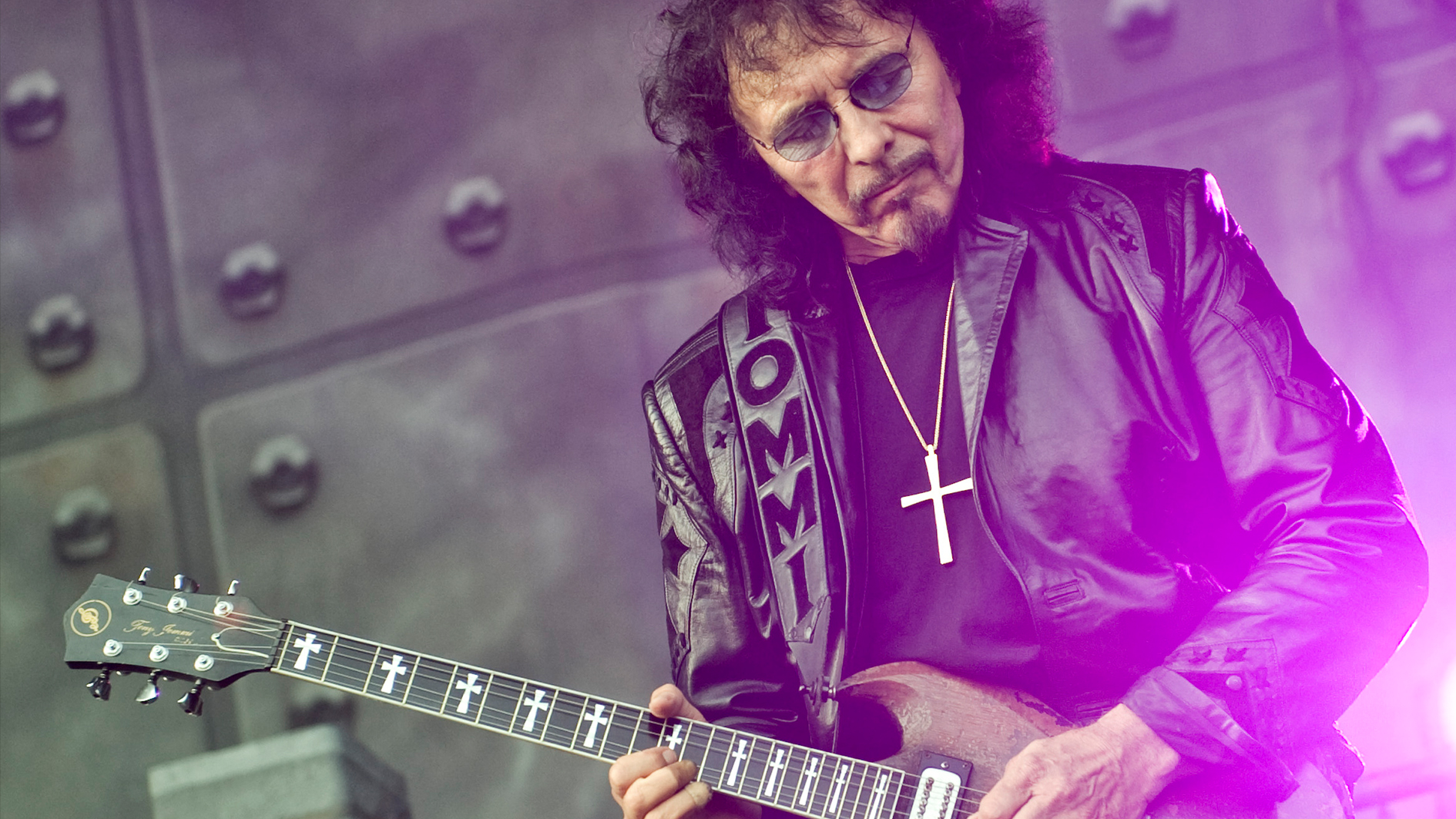
Tony Iommi has spent the last half-century conjuring the loudest, heaviest, most evil-sounding racket known to man and beast. But even he can still be stunned into silence every now and then.
Take, for instance, the moment when the 71-year-old guitarist first laid eyes on his new Gibson model, a note-perfect replica of the cherry red 1964 SG Special (affectionately known as “the Monkey” due to a sticker on its body of a cartoon primate playing a fiddle) that was his primary instrument on the first five Black Sabbath albums - a clutch of records that, together, form something of the ur-text of heavy metal as we know it today.
“I was amazed when I saw it,” Iommi tells Guitar World. “I went, ‘My god!’ It just shocked me.”
The reason?
“This new model is exactly, exactly the same as the original,” he continues. “Right down to every little mark and dent. It’s just incredible.”
Given a guitar as iconic, as heavily modified and, let’s be honest, as weathered as Iommi’s original Monkey, this is no small achievement on Gibson’s part. The company has been responsible for several Iommi signature models over the years, including an impressively appointed Gibson Custom Shop design and an incredibly popular, more affordable Epiphone take.
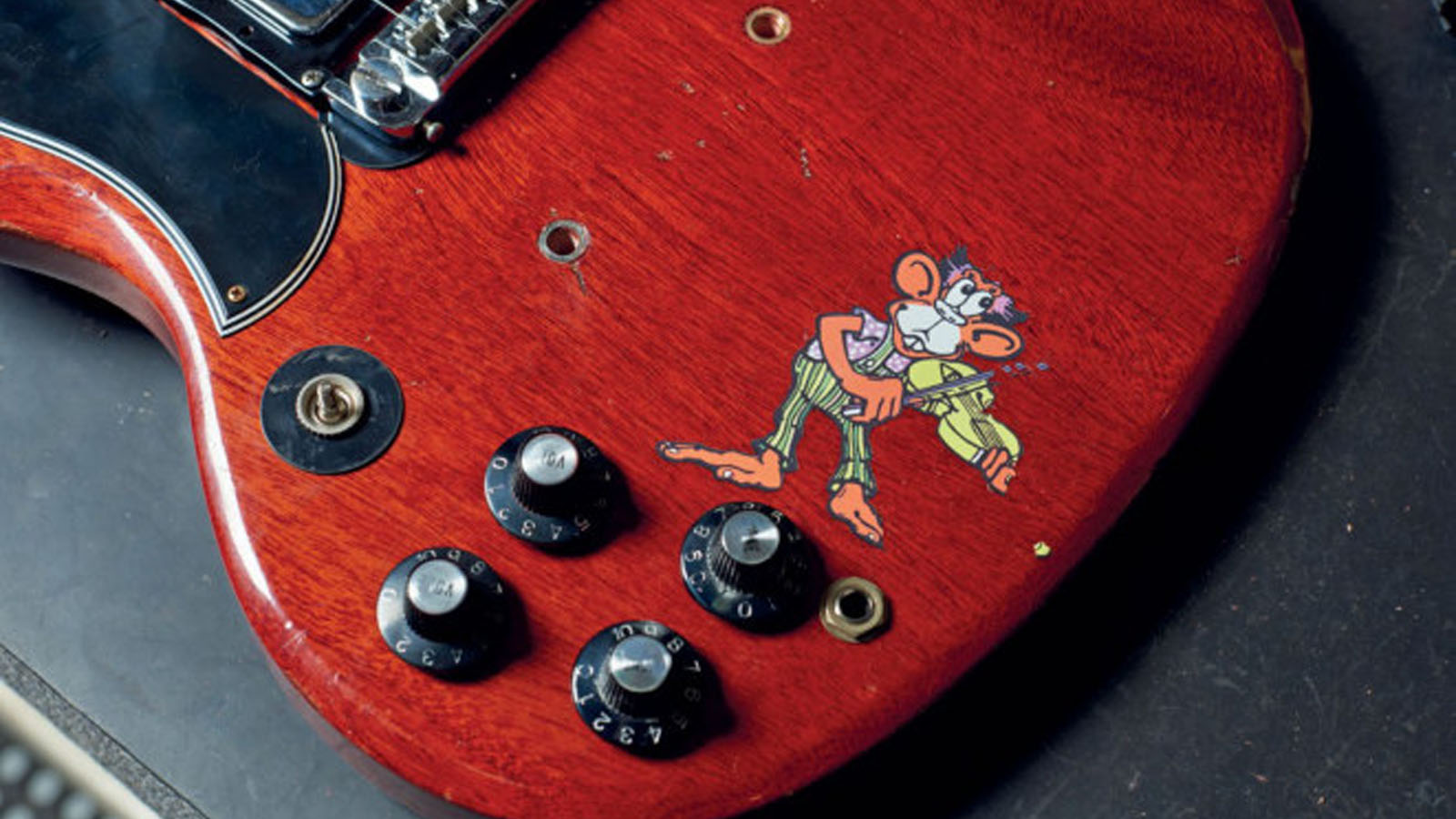
But, Gibson Chief Merchant Officer Cesar Gueikian points out, “We’ve never done the Monkey. And if you think about it, the Monkey is ‘the one.’ ”
All the latest guitar news, interviews, lessons, reviews, deals and more, direct to your inbox!
Indeed it is. Because while Iommi, metal’s original man in black, might be closely associated these days with the sort of ebony-finished, cross-inlaid SG that Gibson and Epiphone have designed in the past, it is the Monkey that is responsible for the oft-imitated, never-duplicated, heavier-than-heavy sound of, for starters, classics like Paranoid, Iron Man and War Pigs.
As for subsequent doom-metal masterpieces like Children of the Grave, Sweet Leaf, Into the Void and Sabbath Bloody Sabbath? That’s all the Monkey, too. And the guitar in hand for the majority of the band’s glory-days-era live shows, including their legendary ’74 California Jam set?
You guessed it - the Monkey. In short, if there’s one guitar that is indelible to the sound of Tony Iommi, to the sound of Black Sabbath, to the sound of heavy metal itself, it has to be this very instrument.
“That particular guitar, I lived with it,” Iommi says of the Monkey. “I had it at the side of my bed. I wouldn’t let anybody touch it. It was so precious to me, because we created the sound together.”
Now Gibson has recreated the guitar behind that revolutionary sound in a very limited run of just 25 left-handed and 25 right-handed examples, each signed and numbered by Iommi himself.
“The original Monkey is now in the Hard Rock Cafe, so they sent it back to us and we did all the scanning and photographing required to create the archive to then do the reissue,” explains Gueikian. Which is no small feat, given that the Monkey is a one-of-a-kind guitar with unique modifications and marks, among them customized pickups, a zero fret and two distinct holes in the body from where the tailpiece was removed.
There’s also the detail of the fingerboard, which Iommi coated in poly lacquer in order to make it easier for him to move his thimble-covered middle and ring fingers (as a teenager he lost the tips of these digits in a mishap at a sheet metal factory) up and down the neck. “I had to be able to slide over the frets easier,” he says.
All of these idiosyncrasies are expertly replicated, with “every check, ding, hole, aged piece, everything in the right place,” Gueikian says about the new guitar.
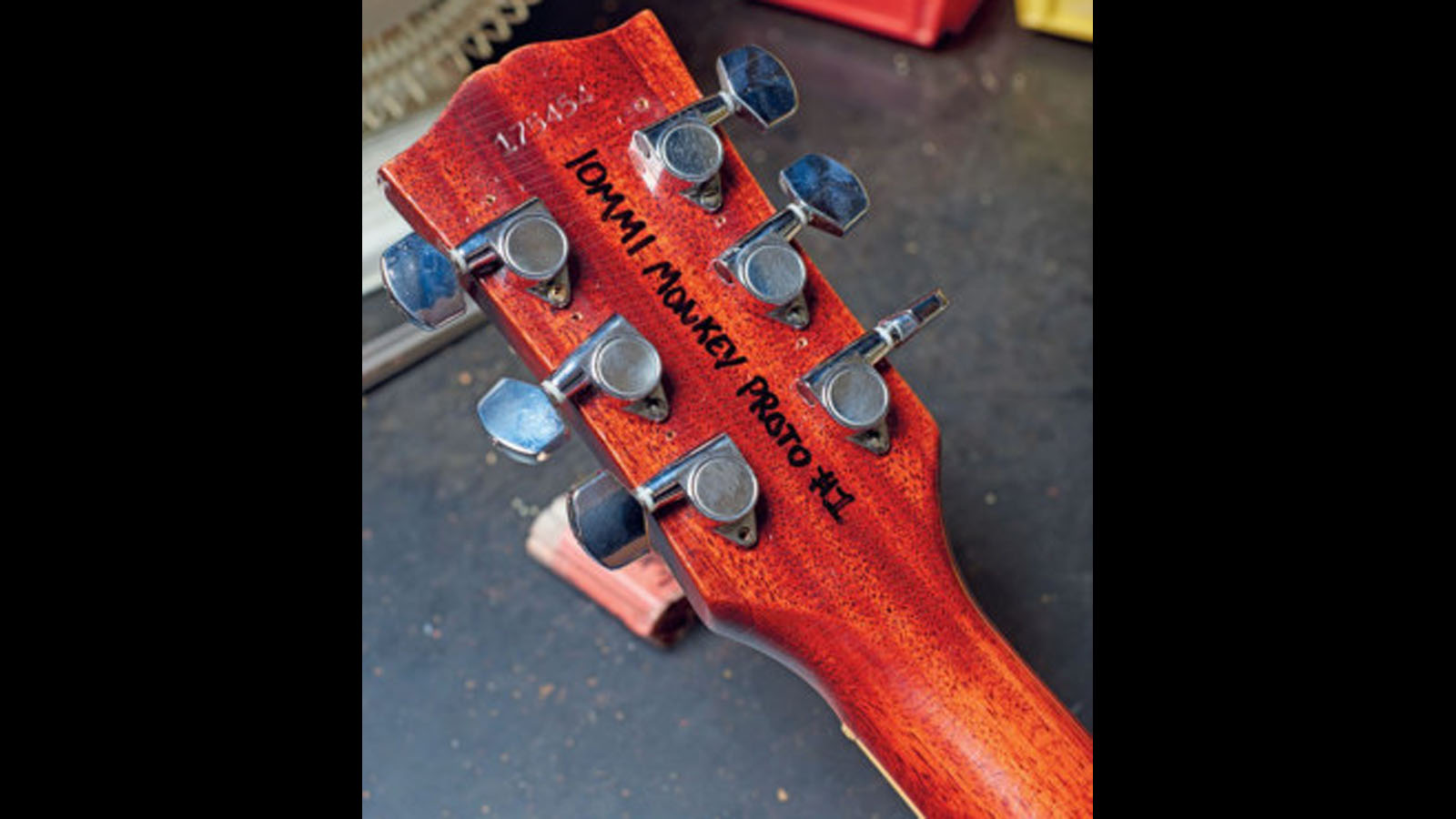
The result is a new Monkey that, in Iommi’s estimation, is not merely just like the original. Rather, he says, “to me this is the original. I don’t miss the original one because this is exactly the same guitar.”
In an exclusive interview with Guitar World, Iommi sat down to discuss the origins of the Monkey and the process of creating the new limited-edition reissue. While we had him in the hot seat, we also took the opportunity to inquire about current goings-on in his musical universe, from the possibility of new music, to what he discussed at his recent airport run-in with Robert Plant, to his long-standing relationship with another British rock golden god, Brian May.
One thing he did tell us with certainty: Whatever the future holds, we’ll all be hearing from Iommi and his Monkey again, and sooner rather than later.
“I’ve got hundreds of riffs,” he says. “So it’s going to happen.”
You’ve worked with Gibson on signature models in the past. It took a long time, but how did the idea to reproduce the Monkey first come up?
In those days, in England, you couldn’t just walk to the shop and go, 'Can I have a new pickup?'
"The idea actually came up years ago. Of course, it didn’t materialize until more recently, since Cesar [Gueikian] got involved, which has changed Gibson completely. They are so on-the-case now, absolutely brilliant.
But yes, we had done a couple of guitars over the years - the Custom one a few years ago, and then it went to Epiphone and we did those. But it just seemed like the right thing to do to reproduce the Monkey, because that’s the guitar you hear on the first five Sabbath albums."
The story behind how the Monkey became your primary instrument is one of almost blind luck. You had been using a Stratocaster in the studio to record the first Black Sabbath record, and when the pickup in that guitar failed, you grabbed the other one at your disposal - the SG Special.
"That’s right. I had long had the SG just as a second guitar, and I’d never really played it - I always used to use my Strat. But we were recording the first album and I played Wicked World and the pickup went. And I thought, Oh no, what do I do now? Because in those days, in England, you couldn’t just walk to the shop and go, 'Can I have a new pickup?'
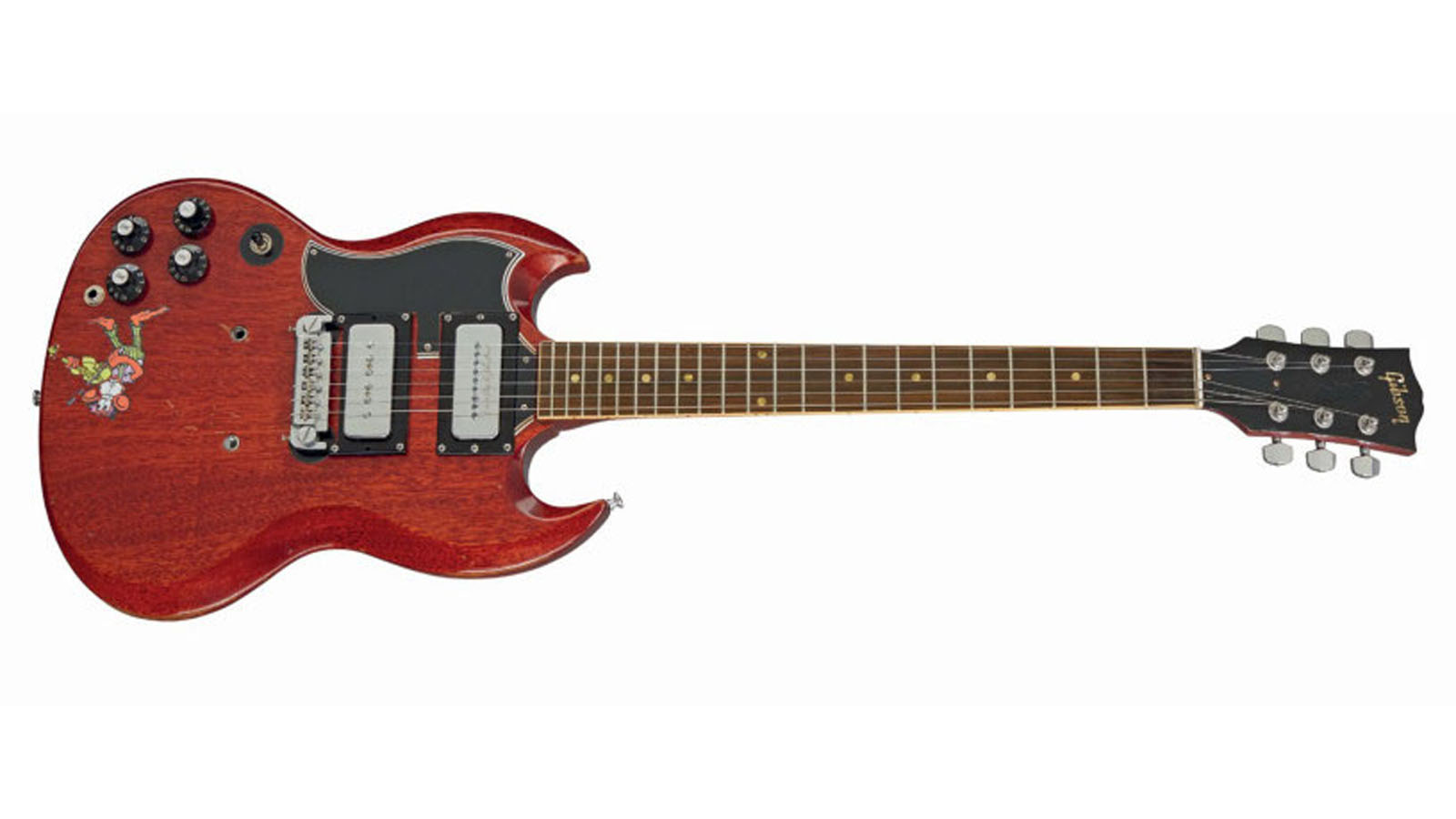
"And not only that, I’d worked on that guitar a lot myself and done things like potted the pickups to get it to feel and sound right. So once that had gone, I said, “Oh, god.” Because we only had that day to start putting the tracks down. So basically I was forced to use the SG. And I’m so glad I did because I really enjoyed playing it and I liked the sound from it. Once I started using it, that was it. I never, ever went back."
What was it about the Monkey that appealed to you?
"I liked that it was light and that you could get up to the upper frets. I had tried Les Pauls before, and they were a bit heavy for me and it was difficult to reach the top [of the fingerboard]. Because certainly for me, having had the accident, my two fingers weren’t that long. But the SG was perfect."
One of the interesting things about the Monkey is that the pickups were P90s. The idea that the legendary Tony Iommi tone - the one that, for all intents, basically created and codified the sound of heavy metal - is the product of single-coils, is somewhat amazing.
"I didn’t even realize it. Because really, you just work out a way to make the guitar you have sound the best it can for you. And that’s what I did. I had the pickups potted because they used to whistle, but otherwise I just really liked the sound of the P90s.
We used to make the pickups and I’d try one in my guitar, and then if it wasn’t right we’d wire up another and try that
"And I used to have a treble booster that I would use to overload the amp, and that combination with the guitar made my sound. As it did with the Strat, to be honest. But with the Gibson it was a lot fuller."
The Monkey’s neck pickup was custom-made by British luthier John Birch, who did a lot of work for you back in those days. What did you like about his P90- style design?
"It had a round sort of sound that was nice for a lot of the jazzy stuff Sabbath would do. So I liked it as the bass pickup for the neck. And you know, when I got involved with John Birch, I originally put money into his company in order to have him make things for me, really.
"But by designing and making them for me, the ideas became available to everybody else as well. But yeah, we used to make the pickups and I’d try one in my guitar, and then if it wasn’t right we’d wire up another and try that. I used to try them out at gigs, actually."
John passed away some years back, but the custom John Birch P90s in the new version of the Monkey were handmade by his apprentice.
"That’s right. And they were copied exactly like what’s in the original."
In addition to John’s work on the pickups, the Monkey also underwent several other mods.
"Yes. I’d had the frets taken down a bit and the neck lacquered. I did that because of my thimbles - when I would run my fingers up and down the neck, they would catch on the frets. So I had to do it all different from how regular people would play. And the lacquer helped with that."
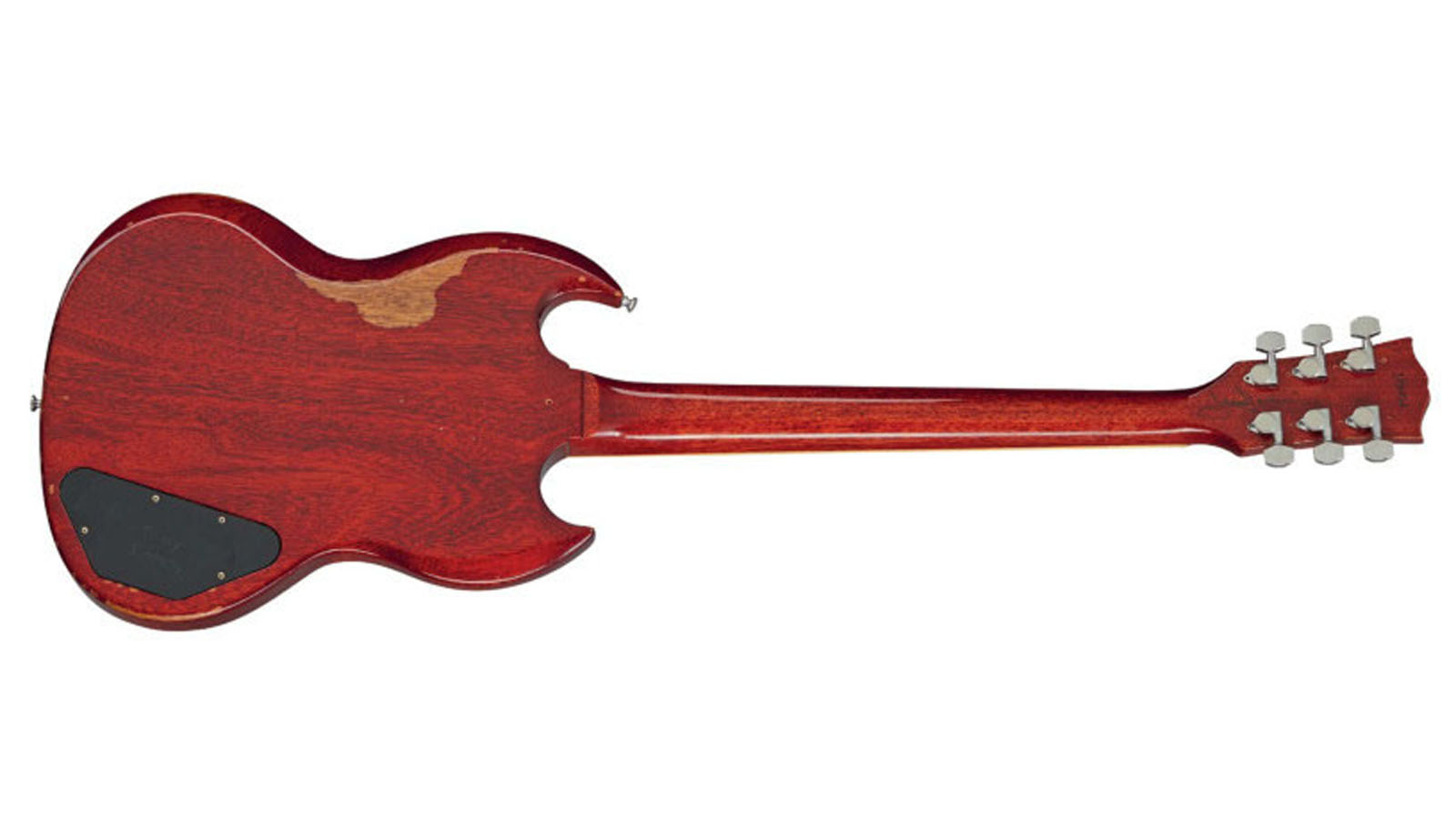
The lacquered neck is something that we see on this new Monkey as well.
"Yes. Although on my original guitar I had it built up a bit more so the frets would flow in. On the one that we’ve done with Gibson it’s not quite like that - it’s just lacquered. So it’s not going to affect the playing for other people as much. And then the addition of the zero fret, I liked that because it made the guitar easier for me to tune. It seemed to be better.
"That was the reason why I changed any of these things, like the bridge. When the guitar first came to me it had just the regular Gibson metal tailpiece. But I wanted to try different stuff. And then I just left the tailpiece off the guitar entirely. Hence the two holes that are in the body."
And Gibson has replicated everything flawlessly on the new model, right down to those holes?
They replicated everything. Even down to the rusty screws. [Laughs] It’s unbelievable
"They replicated everything. Even down to the rusty screws. [Laughs] It’s unbelievable. I mean, I’ve got one here in my house - I keep it in my bedroom. And every night I have a little play on it and it’s just like the original one. They made it so good. All the aging is just the same - the marks where it’s rubbed away naturally, they’ve reproduced all of that. It’s very, very good."
So now on to the most obvious of all questions: Where did the monkey sticker on the body come from?
"[Laughs] Of course. I used to have this jacket that was a very ordinary sort of jacket. I wanted to wear it onstage and I thought, Well, it looks a bit too plain… So I started getting these transfers from different places and sewing them or sticking them on my jacket - they were stars and things like that.
"Then I found these monkey stickers and I thought, Well, that’s good, too. I stuck a couple of them on my jacket and I had some left over, so I put one on my guitar. And there it stayed, forever!"
So there was no real significance to the image of the monkey itself.
"No. It was just a sticker that I had and that I liked. But once I put it on the SG everybody started referring to it as the Monkey guitar. And that was that."
How about the origin of the guitar itself? How did you acquire it?
"That’s another story! This is before Sabbath, when I was playing in a band with [Black Sabbath drummer] Bill Ward called the Rest. And I think it was the bass player we had that said, “Oh, there’s a right-handed Gibson going up for sale, but you’d have to play it upside down.” I figured, great. Because in my day it was hard to get a left-handed Gibson. So I managed to get this right-handed SG for the right price.
"I restrung it the other way and started to play it. And then I heard through the grapevine about this guy who was right-handed and got a left-handed SG and was playing that upside down. I thought, That’s weird… So I managed to get his number and we hooked up and then met in a car park. [Laughs]
"I didn’t know him at all, but he tried my guitar and I tried his and we just swapped. And that’s how I got the Monkey. It’s a peculiar story, really. I’m amazed it ever happened."
Between being a lefty and losing the tips of two of your fret-hand fingers, you were really facing a lot of challenges.
It certainly wasn’t easy. I couldn’t just walk into a shop and pick up a guitar and play, because there weren’t really any left-handed guitars in England
"It certainly wasn’t easy. I couldn’t just walk into a shop and pick up a guitar and play, because there weren’t really any left-handed guitars in England. And then after I had my accident, it was really an uphill struggle. I had to try and invent a new way of playing that would feel comfortable to me.
"I had to get the right strings, because I couldn’t play with heavy strings - they would rip the ends of the thimble right off. So I made my own set. First I started off with banjo strings, and then I searched through other gauges to make something that would work."
Through all that searching, you basically developed an entirely new sound and style of rock guitar.
"Yeah. Part of that was because, being the way I was, it was difficult for me to play chords the way I would have before my accident. So I had to focus on making a sound as big as I could - especially within Sabbath, where we were just a four-piece. I was trying to do as much as possible to make the sound fatter."
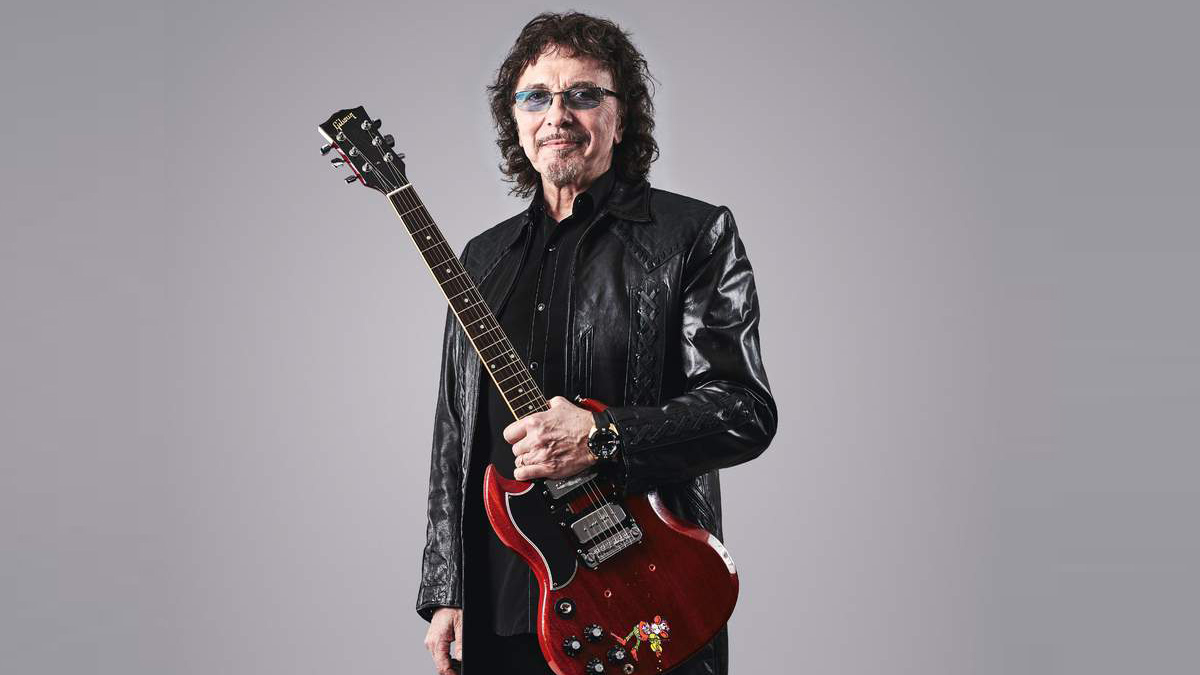
You recently visited the Gibson Custom Shop in Nashville to view and sign the full run of new Monkey guitars. As you were leaving town, you were photographed at the Nashville airport chatting with Robert Plant. I have to ask - what was that all about?
"Well, Planty and myself have known each other since the '70s and we do see each other from time to time. But it was just chance that we met that day. I went into the airport lounge and he was in there, so we had a chat. I think I showed him some riffs I had on my phone.
"Then people started coming up asking for photos, and Robert said to them, 'No, we don’t want to start any rumors. Because if Ozzy finds out I’ll be in trouble!' [Laughs] And of course, somebody still took a picture without us knowing."
There’s always a picture.
"Oh, yeah. It’s amazing how they turn up. [Laughs]"
Well, as far as rumors, there have always been stories about Led Zeppelin and Black Sabbath jamming together back in the day.
In fact, John Bonham was the best man at my wedding. I knew him from before he was in Zeppelin - he used to play in a lot of local bands
"We’ve been friends for a long time. In fact, John Bonham was the best man at my wedding. I knew him from before he was in Zeppelin - he used to play in a lot of local bands, and usually he’d be in one for five minutes and then he’d get fired ’cause he was too loud. [Laughs]
"Then I’d see him another week in another band. In them days it was hard for his bands - they couldn’t get gigs because he was so loud. So he didn’t last that long in ’em!"
So how did you wind up jamming together later on?
"John used to come to Sabbath gigs and I used to go to his gigs when he was first with Zeppelin. So we used to see each other, and then every once in a while he’d pop down to the studio, him and Planty. So this time that you’re talking about, Sabbath was in the middle of recording, and of course once they showed up at the studio, that was the end of that!
"They came in and John goes, 'Ah, let’s have a jam, let’s play Supernaut.' And we did. We’ve got tapes of it somewhere. I mean, I’ve got so many tapes, I don’t even know where they are now, but there is a recording."
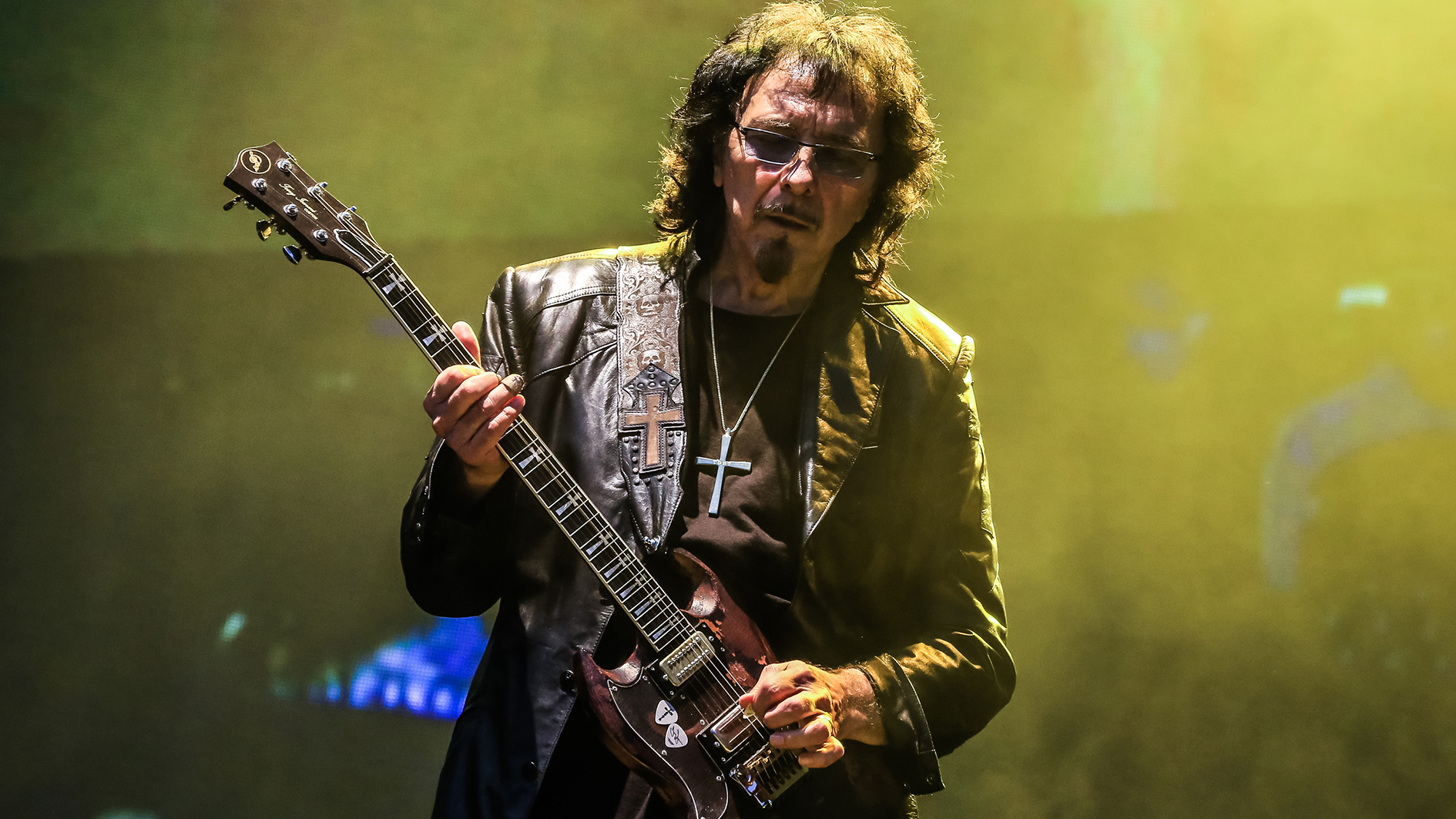
You mentioned earlier that when you ran into Robert in Nashville you showed him some riffs. Does that mean we’re going to hear new music from you?
"Oh, I certainly hope so. How it started with Robert is we were talking about what we’re doing and I said, 'I’ve got so many riffs.' And I was showing him on my phone, rolling through how many I’ve got.
"So, yes, I want to start putting some stuff down. I was putting ideas down last year, but I haven’t done anything with them as yet. I’ve been working on and off with Mike Exeter, who has been my engineer for years now, remixing [Black Sabbath’s 1995 effort] Forbidden, the old Tony Martin/ Cozy Powell/Neil Murray record, and we’ve really taken our time with that.
"But I said to Mike, 'Once we’ve got this out of the way, we need to start putting these riffs down.' So it’s in the pipeline.
Do you have an idea of how you’d like to present this new music? A solo album? Or perhaps a band format?
Brian May came over a few months ago and we sat outside and I was playing him some of them. And he said, 'You’ve got to do something with these'
"I might do some stuff for films or for a TV series or something. I’d like to just get everything down and then decide if I’m going to have a singer or what else. But I’ve got hundreds of riffs. Brian May came over a few months ago and we sat outside and I was playing him some of them. And he said, 'You’ve got to do something with these - we’ve got to do something with these.'
"Because we’ve talked about putting some stuff down. So I gave him three or four CDs full of riffs and he took off with them. And you know, he’s busy with Queen stuff all the time. But when the time is right, I suppose we will do something."
The possibility of you and Brian working together is another rumor that’s been going around for years.
"Yeah, the rumor has been around for years! And we have been talking about it. Every time we get together we go, 'We must do that…' But it’s about getting the time to do it. So it’s just a matter of making a plan."
Any other rock music royalty who you’ve had designs on getting together with for a jam?
"Not really. Because if I start saying, 'I’d like to work with so and so…' then I would just go and do it. But there’s some great people out there. I’ve always had a little bit of a fascination about doing something with Tom Jones. I like his voice. I like his registry. I bet that’d be good. But in general, if something did come along that was interesting, I’d certainly think about it."
As far as Black Sabbath is concerned, you called your last tour The End. But as we see over and over with rock bands these days, it’s never really the end, is it?
"Well, you never know, do you? I’d like to play with the guys again, but we certainly won’t be doing world tours, that’s for sure."
How about recording? The last Sabbath album, 2013’s 13, was incredibly strong.
"Yeah. And I thought we were going to do another album after that. But we didn’t. I had some stuff ready to play for the guys but we ended up going out touring and that sort of took over, really. Because I think everybody was thinking, Oh god, if we do another album, it’s going to take ages. And so we ended up just doing the tour."
So is there a possibility that you guys would ever cut new music together?
The old Monkey used to be by my side all the time - when I used to go on tours I’d take it on the plane myself. I never let it out of my sight
"I wouldn’t think so. But you can never say never, can you? I mean, the amount of times I’ve said no and things have happened, whether with Dio or other situations… So it’s hard to say, 'We’ll never do that again,' because I don’t know. It’s highly unlikely, but you never know."
Well, whatever music you do wind up writing and recording in the future, do you envision that the new Monkey will play a role in its creation?
"Oh, absolutely. I really love this guitar. And I’m not just saying that. I’m so pleased with it. I play it every night. And you know, the old one used to be by my side all the time - when I used to go on tours I’d take it on the plane myself. I never let it out of my sight.
"And this one feels exactly the same to me. I get the same vibe from it, which is unusual for me because I’ve got hundreds of guitars. But it really does feel like something special. It feels like home, you know?"
Rich is the co-author of the best-selling Nöthin' But a Good Time: The Uncensored History of the '80s Hard Rock Explosion. He is also a recording and performing musician, and a former editor of Guitar World magazine and executive editor of Guitar Aficionado magazine. He has authored several additional books, among them Kurt Cobain: Montage of Heck, the companion to the documentary of the same name.

